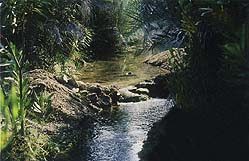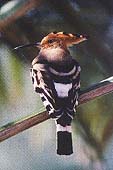UAE MAKES EXTRA EFFORT TO PROTECT WILDLIFE
Pictures by Peter Hellyer & Mike Hill
 At a Governmental level, one key step taken has been the formal
establishment of the Federal Environmental Agency, which replaces
the former Higher Environmental Committee, but has substantially
more in the way both of responsibility and of the power to carry
out policy. Charged with the task not only of ensuring that public
health requirements are taken into consideration, such as in spheres
like air and marine pollution, but also with protecting the environment
and wildlife, the new Agency is responsible for implementing environmental
impact assessments on all major new projects, and of producing
recommendations for wildlife conservation.
At a Governmental level, one key step taken has been the formal
establishment of the Federal Environmental Agency, which replaces
the former Higher Environmental Committee, but has substantially
more in the way both of responsibility and of the power to carry
out policy. Charged with the task not only of ensuring that public
health requirements are taken into consideration, such as in spheres
like air and marine pollution, but also with protecting the environment
and wildlife, the new Agency is responsible for implementing environmental
impact assessments on all major new projects, and of producing
recommendations for wildlife conservation.
In November the Cabinet endorsed an FEA proposal for the introduction of a formal ban on the import of houbara bustards into the country: a move that the Cabinet warmly endorsed, noting that it was in line with the country's membership of the Convention on International Trade in Endangered Species of Flora and Fauna, CITES.
There have been developments over the past year at a less formal level too. The oldest of the country's environmental bodies, The Emirates Natural History Group, became the UAE's first non-governmental member of the World Conservation Union, IUCN, and a second application for membership has now been lodged by the Abu Dhabi based National Avian Research Centre, while FEA officials are reviewing the possibility of the Agency making a formal application to become the UAE's state member, both to benefit from the access to international expertise on conservation matters, and to underline the Government's commitment to these matters in general.
A number of new voluntary groups have also sprung up over the course of the last few months, with Emirates Environmental Groups being established in the main cities of Abu Dhabi and Dubai, which are working closely with the local Municipalities to encourage recycling and a better understanding of the need to keep the environment clean. An Arabian Leopard Trust has also been established by concerned volunteers in Dubai, with the objective of encouraging all sectors of society to recognise the need to preserve the UAE's endangered species of cats, including the caracal lynx and Gordon's wildcat.
 Concern for environmental matters within the Emirates is by no
means new, however. For more than fifteen years hunting has been
banned throughout much of the country, while the taking of bird
or turtle eggs is also illegal. While breaches of the law still
sometimes occur, a combination of legal pressure and persuasive
education is gradually getting the message across, and the available
scientific evidence suggests that some of the country's wildlife,
such as the Cape hare and the Arabian gazelle, is already benefiting.
Concern for environmental matters within the Emirates is by no
means new, however. For more than fifteen years hunting has been
banned throughout much of the country, while the taking of bird
or turtle eggs is also illegal. While breaches of the law still
sometimes occur, a combination of legal pressure and persuasive
education is gradually getting the message across, and the available
scientific evidence suggests that some of the country's wildlife,
such as the Cape hare and the Arabian gazelle, is already benefiting.
Extensive afforestation programmes in which nearly a hundred million trees have been planted throughout the UAE, many of them in towns and cities, have had a dramatic impact on the availability of natural food and shelter for many species of wildlife. At least 100,000 hectares of open desert land has been transformed into woodland and many of the plantations are now reaching maturity. With a steady supply of freshwater, primarily from desalination plants or through recycling systems, new habitats have been created which have proven to be attractive for both resident birds and migrants. The number of bird species breeding in the Emirates, for example, has shown a steady increase in recent years. Previously uncommon migrants such as the olivaceous warbler and the European bee-eater benefit considerably from this rapid increase in vegetation cover.
There has been progress too in another field, that of the breeding of endangered species. For the past few decades President Sheikh Zayed has been breeding animals like the Arabian gazelle and the Arabian oryx on the island of Sir Bani Yas, now effectively a private wildlife reserve. The oryx, descended from a couple of pairs caught from the wild thirty years ago, have risen in number to 120 animals now inhabiting the island, whilst the gazelle numbers are now so substantial, at around 20,000, that the first phase of a reintroduction programme into the mainland desert has begun.
Looking beyond the success of the captive breeding programme, there are now plans, within the framework of the relevant CITES regulations, to develop exchange programmes with other wildlife parks and zoos world-wide.
There still remains much to be done, both in terms of enhancing public awareness of the need to protect the environment and wildlife, and in terms of ensuring that the existing legislation is effectively implemented. It has become clear over the course of the past year that the will to provide the necessary level of environmental protection is present as never before, thanks to a very considerable extent to the personal encouragement given by the President himself to many of the initiatives that have been taken. This level of commitment and support bodes well for the future of the UAE's wildlife.
Web Links | Subjects | Search
Arabian Wildlife. Volume 1, Number 1